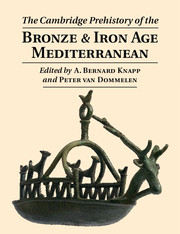Book contents
- The Cambridge Prehistory of the Bronze and Iron Age Mediterranean
- The Cambridge Prehistory of the Bronze and Iron Age Mediterranean
- Copyright page
- Contents
- Illustrations
- Contributors
- Preface
- Mediterranean Introductions
- Insularity and Connectivity
- Mobility, Migration and Colonisation
- 7 Corridors and Colonies: Comparing Fourth–Third Millennia BC Interactions in Southeast Anatolia and the Levant
- 8 The Anatolian Context of Philia Material Culture in Cyprus
- 9 Bronze Age European Elites: From the Aegean to the Adriatic and Back Again
- 10 Greece in the Early Iron Age: Mobility, Commodities, Polities, and Literacy
- 11 Before ‘the Gates of Tartessos’: Indigenous Knowledge and Exchange Networks in the Late Bronze Age Far West
- 12 Colonisations and Cultural Developments in the Central Mediterranean
- 13 The Iron Age in South Italy: Settlement, Mobility and Culture Contact
- Hybridisation and Cultural Encounters
- Materiality, Memory and Identity
- Community and Household
- Life and Death
- Ritual and Ideology
- Index
11 - Before ‘the Gates of Tartessos’: Indigenous Knowledge and Exchange Networks in the Late Bronze Age Far West
from Mobility, Migration and Colonisation
Published online by Cambridge University Press: 18 December 2014
- The Cambridge Prehistory of the Bronze and Iron Age Mediterranean
- The Cambridge Prehistory of the Bronze and Iron Age Mediterranean
- Copyright page
- Contents
- Illustrations
- Contributors
- Preface
- Mediterranean Introductions
- Insularity and Connectivity
- Mobility, Migration and Colonisation
- 7 Corridors and Colonies: Comparing Fourth–Third Millennia BC Interactions in Southeast Anatolia and the Levant
- 8 The Anatolian Context of Philia Material Culture in Cyprus
- 9 Bronze Age European Elites: From the Aegean to the Adriatic and Back Again
- 10 Greece in the Early Iron Age: Mobility, Commodities, Polities, and Literacy
- 11 Before ‘the Gates of Tartessos’: Indigenous Knowledge and Exchange Networks in the Late Bronze Age Far West
- 12 Colonisations and Cultural Developments in the Central Mediterranean
- 13 The Iron Age in South Italy: Settlement, Mobility and Culture Contact
- Hybridisation and Cultural Encounters
- Materiality, Memory and Identity
- Community and Household
- Life and Death
- Ritual and Ideology
- Index
Summary
- Type
- Chapter
- Information
- Publisher: Cambridge University PressPrint publication year: 2015
- 6
- Cited by

